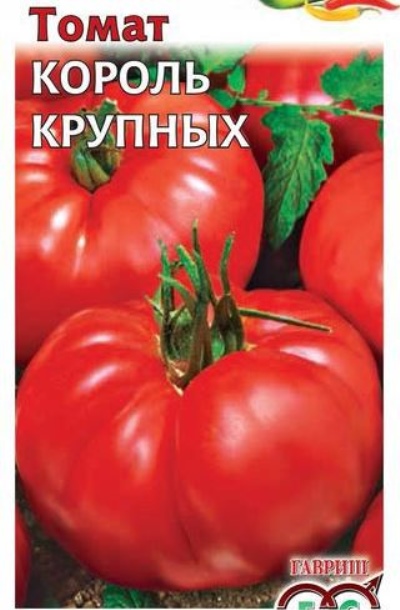
- Category: grade
- Growth type: indeterminate
- Appointment: fresh consumption, for pickling and preserving
- Ripening period: mid-season
- Ripening time, days: 110-115
- Growing conditions: for film greenhouses
- Marketability: high
- Bush size: tall
- Bush height, cm: 180-200
- Ripe fruit color: red-crimson
The name of the tomato King of large is pretentious. However, it is important to figure out how much it corresponds to reality. And also it is worth figuring out exactly how to grow such a culture.
Description of the variety
The indeterminacy of the King of the Large is confirmed by the experience of a large number of gardeners. The plant is ideal for a plastic greenhouse. Its bushes can grow up to 1.8-2 m. In terms of its vegetative qualities, the King of large stands out favorably even against the background of a number of advanced varieties.
The main qualities of the fruit
Ripe berries will have a red-crimson color. The color will be bright, the skin has a glossy sheen. These large tomatoes weigh an average of 550 g. They are shaped like a flat circle. The largest specimens can reach a mass of 1 kg.
Taste characteristics
In the description of the taste of the King of Large, it is mentioned that it contains a dominant sweet line. The acid inclusion is also present, but it does not produce an unpleasant effect. Almost every consumer likes a balanced dessert taste. It is definitely no worse than the vast majority of popular varieties. The meatiness and juiciness are also quite compelling benefits.
The crop is used:
fresh;
for the manufacture of tomato juice;
when preparing salads;
as a raw material for sauce, ketchup or tomato paste.
Ripening and fruiting
The king of large is a mid-season tomato. The readiness of the fruits is reached 110-115 days after the formation of green shoots. Then fruiting will take a long time. In this respect, the variety does not cause any complaints.
Yield
Fee per 1 sq. m is from 5 to 7 kg of berries. Therefore, we can say that the King of large is ahead of many very popular varieties of tomatoes. The specific result depends on the weather and agrotechnical measures. Some sources note that the collection can reach 8 or even 10 kg, and therefore it makes sense for summer residents to try.
The timing of planting seedlings and planting in the ground
It is necessary to start planting seeds in containers at the end of March. Sometimes this procedure is performed in early April. Gardeners should be guided by a convenient moment for themselves. Transfer to open ground is carried out at the end of April or in the middle of May. These terms can be determined as accurately as possible taking into account the actual weather and the degree of warming of the earth.

Growing tomato seedlings is an extremely important process, because it largely depends on whether the gardener can harvest at all. All aspects must be taken into account, from seedbed preparation to planting in the ground.
Landing scheme
The holes should be arranged according to the 400x600 mm scheme. There should be 3 or 4 plants per 1 m2. Traditionally, the choice between these options is determined by the personal priorities of the gardener. Important: seedlings dive in advance. This should be done when 2 real leaves appear on the bush.

Growing and care
Removing stepchildren will be strictly mandatory. And also the formation of bushes is an indispensable moment. They should be arranged in 1 or 2 stems. It is hardly wise to use more stems. Although the likelihood of cracking the fruit is small, you need to additionally be reinsured.
The planting holes must first be filled with compost and superphosphate. Complete care includes:
feeding with mixtures containing phosphorus, nitrogen and potassium;
watering with warm, settled water under the root;
loosening the soil 1 time in 7-10 days, and also if necessary (if it is excessively compacted).
During the planting phase, it is advisable to select the seeds very carefully. After passing the ascent test in water, they are soaked in wet gauze. It is advisable to use growth activators in order to get a more impressive result. Planting seedlings in open areas or in greenhouses is traditionally timed to coincide with cloudy weather. This allows relatively delicate seedlings to avoid sunburn.
It is important to remember that ripe berries are the same color. Once this condition is met, the crop should be harvested. For a long time on the branches by itself, it does not sag. Top dressing is carried out at intervals of 14 days. Along with traditional pegs, trellis with wire stretched over them can also be used as supports.




A plant needs different micronutrients at each stage of growth. All fertilizers can be divided into two groups: mineral and organic. Folk remedies are often used: iodine, yeast, bird droppings, eggshells.
It is important to observe the rate and period of feeding. This also applies to folk remedies and organic fertilizers.



























































































